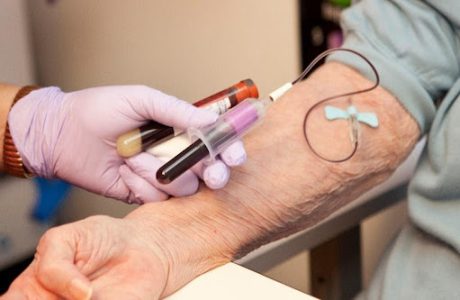If you have ever had your blood drawn at the doctor’s office or donated to a blood drive, chances are you have met a phlebotomist! Phlebotomists, or phlebotomy technicians, draw blood from patients at health care facilities. In this post, we will explain how to become a phlebotomist in just four steps. Read on to learn how you can start working as a phlebotomist soon!
How to Become a Phlebotomist
Becoming a phlebotomist requires some post-secondary education but not a full bachelor’s degree. This means you may be able to start your phlebotomy career in less than a year, depending on the educational program you choose and how you progress towards your goal.
Some people in this role choose to pursue a national certification. A phlebotomy certification is a great way to improve your job prospects. We’ll talk more about this below.
Ready to learn how to become a phlebotomist? Below are the four steps you can follow to pursue an in-demand healthcare career as a phlebotomist! (1)
Begin your phlebotomy technician career journey today!
1. Obtain high school diploma or equivalent
Vocational schools and community colleges usually require applicants to have a high school diploma or an equivalent (like a GED). This means that in order to enroll in a phlebotomy training program you may need to have one of these prerequisites.
2. Enroll in a phlebotomy program
Next, it’s time to find a phlebotomy program and enroll. Most programs require a high school diploma or GED. Other than that, you may not need any additional education or background experience in the medical field. Be sure to check your school’s admissions requirements though, just to make sure.
A phlebotomy program with a robust curriculum will likely cover the following:
- Blood collection
- Laboratory procedures for processing and distributing specimens
- Phlebotomy safety standards
- Quality control procedures
- Infection control
- Communication and documentation skills
- Medical terminology – like “venipuncture”
- Anatomy
- Legal and ethical considerations of working in health care
Hands-on practice is extremely important for phlebotomists in training. Drawing blood with needles must be done with careful precision. For newcomers to the field, the idea of poking patients with a needle can be daunting. Luckily, phlebotomy programs can provide plenty of opportunities for students to practice using blood drawing equipment to collect samples. In phlebotomy training programs, students can get hands-on practice by using their fellow classmates as volunteer test patients.
Once you have completed a phlebotomy program at a vocational school or community college, you can decide whether you’d like to become a certified phlebotomy technician. Being certified can improve your chances of landing a job in the field.
3. Earn your phlebotomy certification
Becoming a certified phlebotomy technician could make you a more desirable job candidate because it shows that you have mastered phlebotomy skills.
In order to earn your phlebotomy certification, follow these steps:
- Complete a phlebotomy program at a vocational school or community college.
- Choose a certification to pursue (some options are listed below).
- Complete the required number of live sample collection procedures.
- Sign up to take the certification exam.
- Study and review skills.
- Take (and pass) the exam.
- Fulfill any other requirements.
- Receive your certification!
Popular phlebotomy certifications include the following:
- National HealthCareer Association Certification
- American Society for Clinical Pathology Certification
- American Society of Phlebotomy Technicians Certificate
- Registered Phlebotomy Technician from the American Medical Technologists
- National Phlebotomy Association Certification
Once you have passed your exam, fulfilled the necessary requirements, and received your phlebotomy certification, you can’t just put it in a file and forget about it. All certifications need to be renewed periodically. Most certifications require renewal every one to three years. To renew, some certifications simply require a renewal fee. However, some certification bodies, like the American Society for Clinical Pathology also require you to complete a certain number of continuing education credits as well.
4. Pursue your career as a certified phlebotomist
Once you have graduated from a phlebotomy program and successfully passed the certification exam, you are ready to begin job hunting. Phlebotomists can look for work in hospitals, private practices, blood donation centers, laboratories, or any other facility where blood samples are drawn.
According to the Bureau of Labor Statistics, phlebotomy jobs are projected to grow by 22% between 2020 and 20301 – which means demand for this role is growing!
Start Your Journey Today and Become a Phlebotomy Technician!
Becoming a phlebotomist is a great way to enter the medical field if you don’t have a bachelor’s degree and are not able to attend medical school. With training programs that can be completed in just three to four weeks, diligent students may be able to start working in their new career in less than a year!
Ready to start your career journey in phlebotomy? The first big decision you need to make is which program to enroll in. Become a phlebotomist with the help of Training Direct’s comprehensive phlebotomy technician program. This program covers the major topics we mentioned above and offers plenty of opportunities for hands-on training.
Best of luck on your path to becoming a phlebotomist!





